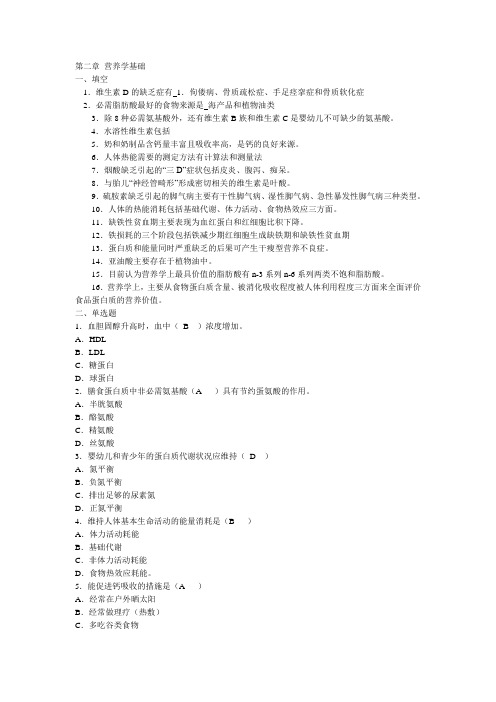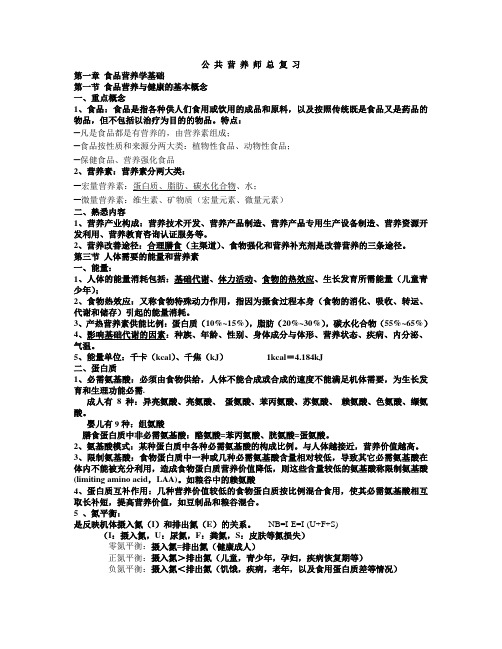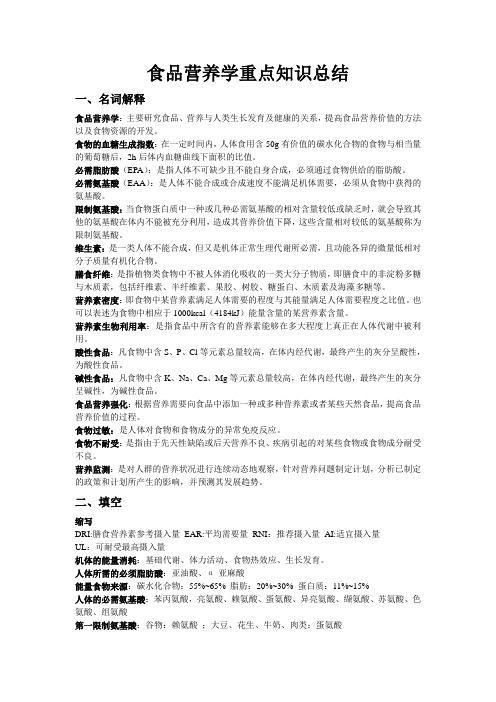食品营养学基础
食品营养学基础知识

食品营养学基础知识引言食品营养学是研究食物中所含的营养物质以及它们在人体内的吸收、利用和代谢的科学。
了解食品营养学的基本知识对于保持健康和正确的饮食习惯非常重要。
本文将介绍食品营养学的一些基础知识,包括营养物质分类、摄入量推荐、以及常见的营养缺乏症。
1. 营养物质分类根据其在人体内的作用和需求,营养物质可以分为以下几类:1.1 碳水化合物碳水化合物是人体获得能量的主要来源,也是大脑活动的首选能源。
它们可以分为简单碳水化合物和复杂碳水化合物。
简单碳水化合物主要来自于糖分,例如果糖和葡萄糖。
复杂碳水化合物主要来自于粗粮和蔬菜,例如面包、米饭和土豆。
1.2 脂肪脂肪是人体能量储备的重要来源。
它们分为饱和脂肪、不饱和脂肪和反式脂肪。
饱和脂肪主要来自于动物脂肪和椰子油等植物油,摄入过多可能会增加患心血管疾病的风险。
不饱和脂肪主要来自于鱼、坚果和橄榄油等食物,对心血管健康有益。
反式脂肪主要来自于加工食品和深度煎炸的食物,摄入过多可能会增加患心血管疾病的风险。
1.3 蛋白质蛋白质是人体合成组织和细胞的基本物质,也是构成酶、激素等生物活性物质的主要成分。
它们主要来自于动物食物,例如肉、鱼、禽类和乳制品,以及植物食物,例如豆类和谷物。
蛋白质是维持健康的重要营养物质,但摄入过多也可能对肾脏健康产生负面影响。
1.4 维生素维生素是人体正常生长和代谢所必需的有机化合物。
它们根据其溶解性可分为水溶性维生素和脂溶性维生素。
水溶性维生素包括维生素B族和维生素C,脂溶性维生素包括维生素A、维生素D、维生素E和维生素K。
不同维生素有不同的功能和来源,摄入充足的维生素对于维持身体的正常功能至关重要。
1.5 矿物质矿物质是构成人体组织和液体的无机物质。
常见的矿物质有钙、铁、锌、镁等。
它们对于维持身体的结构和功能至关重要,例如钙是构成骨骼和牙齿的重要成分,铁是血红蛋白合成的必需元素。
2. 摄入量推荐根据不同人群的需求,食物摄入量推荐可以有所不同。
食品营养学复习资料

第二章营养学基础一、填空1.维生素D的缺乏症有1.佝偻病、骨质疏松症、手足痉挛症和骨质软化症2.必需脂肪酸最好的食物来源是海产品和植物油类3.除8种必需氨基酸外,还有维生素B族和维生素C是婴幼儿不可缺少的氨基酸。
4.水溶性维生素包括5.奶和奶制品含钙量丰富且吸收率高,是钙的良好来源。
6.人体热能需要的测定方法有计算法和测量法7.烟酸缺乏引起的“三D”症状包括皮炎、腹泻、痴呆。
8.与胎儿“神经管畸形”形成密切相关的维生素是叶酸。
9.硫胺素缺乏引起的脚气病主要有干性脚气病、湿性脚气病、急性暴发性脚气病三种类型。
10.人体的热能消耗包括基础代谢、体力活动、食物热效应三方面。
11.缺铁性贫血期主要表现为血红蛋白和红细胞比积下降。
12.铁损耗的三个阶段包括铁减少期红细胞生成缺铁期和缺铁性贫血期13.蛋白质和能量同时严重缺乏的后果可产生干瘦型营养不良症。
14.亚油酸主要存在于植物油中。
15.目前认为营养学上最具价值的脂肪酸有n-3系列n-6系列两类不饱和脂肪酸。
16.营养学上,主要从食物蛋白质含量、被消化吸收程度被人体利用程度三方面来全面评价食品蛋白质的营养价值。
二、单选题1.血胆固醇升高时,血中(B )浓度增加。
A.HDLB.LDLC.糖蛋白D.球蛋白2.膳食蛋白质中非必需氨基酸(A )具有节约蛋氨酸的作用。
A.半胱氨酸B.酪氨酸C.精氨酸D.丝氨酸3.婴幼儿和青少年的蛋白质代谢状况应维持(D )A.氮平衡B.负氮平衡C.排出足够的尿素氮D.正氮平衡4.维持人体基本生命活动的能量消耗是(B )A.体力活动耗能B.基础代谢C.非体力活动耗能D.食物热效应耗能。
5.能促进钙吸收的措施是(A )A.经常在户外晒太阳B.经常做理疗(热敷)C.多吃谷类食物D.多吃蔬菜、水果6.具有激素性质的维生素是(C )A.维生素B1B.维生素B2C.维生素DD.维生素PP7.维生素B2缺乏体征之一是( A )A.脂溢性皮炎B.周围神经炎C.“三D”症状D.牙龈疼痛出血8.能被人体消化吸收的碳水化合物是(D )A.棉籽糖B.果胶C.纤维素D.淀粉9.膳食蛋白质中非必需氨基酸(B )具有节约苯丙氨酸的作用。
食品营养学基础培训课件

食品营养学基础
7
了解各营养素对人体的作用
食品营养学基础
8
1.2 各个历史时期中国人口平均寿命
❖ 夏代 ❖ 秦汉 ❖ 东汉 ❖ 唐代 ❖ 宋代 ❖ 清代 ❖ 民国时期
18岁 20岁 22岁 27岁 30岁 33岁 35岁
❖ 2002年亚太地区社会科学与医 学大会上的权威数字表明中国人 平均寿命为71.4岁 ;2009年, 中国的平均寿命是73.05岁, 其中男性为71.3岁,女性是 74.8岁;联合国04年发表的全 球人口预测报告称,到2300年, 中国人的平均预期寿命将达到 100岁,其中男性平均寿命为98 岁,女性平均为101岁。
食品营养学基础
17
❖ 解放战争期间,渡江战斗中战士阴囊皮炎的流行,抗美 援朝时期,部队中大批战士夜盲症的发生,均极大地影 响了战斗力,但一经采用核黄素或维生素A补充,这些 营养缺乏病就很快痊愈了。建国初期,新疆南部也流行 过癞皮病,且发生在春耕时期,严重影响了当地农业生 产。一方面向流行地区人群补充烟酸,一方面以研究结 果指导当地采取了加碱处理的办法,使玉米中的结合型 烟酸形成游离型需释放,能为人体利用,这种缺乏病就 基本消除了。这些典型事例充分说明了营养缺乏对于国 防建设和人民健康的重大影响。
食品营养学基础
12
❖ 成书于东汉的〈神农本草经〉中,记载了许多食物既可 以信用,还可以药用。如上品中应有大枣、葡萄、海蛤 等22种食品,可养命应天,轻身益气不老延年;中品中 有干姜、海藻、赤小豆等19种,可养性应人,遏病补虚; 下品中有9种食物,可治病应地,除寒热邪气。
❖ 李时珍在《本草纲目》中,将350种食物列入具有治疗作 用的范围,并区分为寒、凉、温、热、有毒和无毒等物 质,以便对症使用。
食品营养和保健营养学基础知识

蔗糖
(sucrose)
麦芽糖
(maltose)
乳糖
(lactose)
海藻糖
(trehalose)
1葡萄糖 1果 糖
2葡萄糖
1葡萄糖 1半乳糖
2葡萄糖
(二)双糖
1.蔗糖 蔗糖是从糖料作物甜菜或甘蔗中提取出来旳
。具有增长机体ATP旳合成、解毒保肝、止 血消炎作用。 过分摄入蔗糖会引起健康问题,例如龋齿旳 发生,对于肥胖症、糖尿病人要严格限制蔗
(2)在动物性肉类食品中旳含 量:内脏高于肌肉,瘦肉高于肥肉, 家禽肉高于家畜肉。
必需脂肪酸需要量
(1)
成人每日供给必需 脂肪酸旳量到达总热能 供给量旳1~2%。
中国营学会提议多 不饱和脂肪酸供能占总 能量旳10%为宜。
(2)值得注意旳是,必需 脂肪酸和多不饱和脂肪酸旳过 多摄入,会对人体产生副作用, 造成过氧化脂质旳增多,增进 衰老。故在日常生活中,既要 预防动物脂肪旳过多摄入,又 要预防植物油旳过多摄入。
碳水化物分类、食物起源
营养学上一般将其分为四类
单糖 双糖 寡糖
多糖
两分子单糖 可消化寡糖 非消化寡糖 可消化多糖 非消化多糖
(一)单糖
以己糖为主,食物中主要有葡萄糖、果糖、半乳糖 ,还有少许其他糖类
1.葡萄糖
它是在人类空腹时唯一存在旳单糖。人体旳血 糖就是指血液中葡萄糖旳含量。葡萄糖主要由淀粉 水解而来。另外,还可来自蔗糖、乳糖等旳水解。 它是机体最以便吸收、利用旳单糖。有些器官实际 上完全依托葡萄糖供给所需旳能量。例如,大脑中 无能量贮备,须有葡萄糖提供,每日约需100~ 120g葡萄糖。要维持大脑进行正常工作,必须保 持一定旳血糖水平,所以在早餐仅提供牛奶加鸡蛋 这么旳高蛋白质食物是不符合营养学要求旳。
食品营养学知识要点整理

⾷品营养学知识要点整理《⾷品营养学》⽼师上课提问的知识要点整理以课本的章节为顺序整理,和⽼师ppt顺序可能有所不同!第⼀章绪论1.⾷品的特点2.⾷品的概念3.营养的概念4.营养素的概念和六⼤营养素5.膳⾷摄⼊参考量DRIs(EAR、RNI、AI、UL)6.健康的概念和⽅⾯7.亚健康的概念8.营养不良的概念和两种表现第⼆章⾷物的体内过程1.消化的概念和两种⽅式2.吸收的概念3.消化系统的组成4.唾液的作⽤5.胃液的组成和相应功能6.⼩肠是⾷物消化的主要器官7.胰液中的酶有哪些8.胆汁的作⽤(胆汁中⽆消化酶)9.碳酸化合物、蛋⽩质和脂肪的开始消化的场所(三者有所不同)10.⾷物吸收的主要部位11.主动运输及哪些物质是通过主动运输12.主要营养素的消化和吸收第三章能量与宏观营养素1.三⼤产能营养素分别是2.三⼤产能营养素的能量系数3.机体的能量消耗由哪四个⽅⾯组成(注意正常成年⼈与孕妇、⼉童等⼈群的不同)4.基础代谢的概念5.基础代谢率的概念6.影响基础代谢率的因素有哪⼏个⽅⾯7.基础代谢的计算8.体⼒活动的能量消耗是⾃主活动9.中国成⼈活动⽔平分级,了解10.不同⾷物的特殊动⼒作⽤,⼜称⾷物的热效应(脂肪、蛋⽩质、碳⽔化合物和混合⾷物的⾷物热效应分别是多少)11.体重评价⽅法及其计算公式(BMI)12.三⼤宏量营养素的功能⽐分别是13.可消化利⽤和不可消化利⽤14.碳⽔化合物的⽣理功能有哪⼏个⽅⾯15.什么是抗⽣酮作⽤和什么物质具有抗⽣酮作⽤16.膳⾷纤维和功能性低聚糖在来源上的区别17.功能性低聚糖的⽣理功能18.⾎糖⽣成指数19.⾷⽤糖或者纯糖制品的营养素密度低20.膳⾷纤维的概念21.膳⾷纤维的⽣理功能22.脂类包括?类脂包括?23.脂类的⽣理功能24.三⼤营养素在胃中的排空速度25.什么是必需脂肪酸?⼈体的必需脂肪酸有哪些?26.花⽣四烯酸是必须脂肪酸吗?27.必须脂肪酸的⽣理功能和缺乏危害28.⼆⼗⼆碳六烯酸有?⼆⼗碳五烯酸有?29.DHA和EPA的良好⾷物来源有?30.脂类的营养价值评价有哪些⽅⾯31.于⼀般成⼈的,SFA、MUFA和32.氨基酸池33.完全蛋⽩、半完全蛋⽩和不完全蛋⽩34.蛋⽩质的⽣理功能35.氮平衡概念和公式36.必需氨基酸、⾮必需氨基酸和条件必须氨基酸的概念37.必需氨基酸的种类38.条件必须氨基酸不仅仅是半胱氨酸和酪氨酸39.氨基酸模式的概念40.限制氨基和第⼀限制氨基酸的概念和应⽤41.蛋⽩质的互补作⽤42.功能性氨基酸有哪些43.蛋⽩质营养价值的评价(6点)44.营养学上主要从哪三⽅⾯全⾯地对蛋⽩质进⾏评价45.氨基酸评分的概念及其计算公式,氨基酸评分的参考蛋⽩是?46.参考蛋⽩的概念47.PDCAAS48.PEM是?49.蛋⽩质营养不良的临床表现有哪两种?分别是由于缺乏什么引起的?各⾃的症状是?50.51.⽔的⽣理功能?52.正常⼈每天饮⽔量?53.体内⽔的来源包括哪三⼤部分?第四章微量营养素1.常量营养素和微量营养素的概念2.7种常量元素是3.8种微量元素是4.钙(重点)5.钙的⽣理功能6.钙的吸收⽅式有哪两种?7.影响钙吸收的因素有哪三个⽅⾯,有利和不利的例⼦分别是?8.钙的缺乏与过量,缺乏病,过量病9.钙的⾷物来源和良好⾷物来源10.磷的⽣理功能11.影响磷吸收的因素12.磷缺乏和低磷⾎症13.体内铁的分类和分布14.⾷物中的铁的存在形式15.影响铁吸收的因素16.铁缺乏是的三个损耗阶段17.铁缺乏和缺铁性贫⾎18.铁的⾷物来源19.锌的⽣理功能20.锌的缺乏症21.锌的膳⾷来源22.克⼭病发病的基本因素是?23.克⼭病:以⼼肌坏死为特征的地⽅病24.硒的缺乏病和良好⾷物来源25.碘的⽣理功能26.碘缺乏和过量27.氟的⽣理功能28.氟缺乏与过量29.铬——葡萄糖耐量因⼦1.维⽣素的概念2.维⽣素的3种命名系统3.⽔溶性维⽣素有4.脂溶性维⽣素有5.脂溶性维⽣素摄⼊过多可在体内蓄积6.维⽣素A的别称7.视黄醇当量及其计算公式8.维⽣素A的缺乏症有哪些9.维⽣素A过量症10.维⽣素D的别称有哪些11.维⽣素D的缺乏症有哪些12.维⽣素D的膳⾷来源13.维⽣素E的别称14.维⽣素E的⽣理功能15.维⽣素E缺乏症16.维⽣素B1别称17.维⽣素B1缺乏症18.维⽣素B2的⼜称19.维⽣素B2缺乏症20.尼克酸的别称21.尼克酸缺乏症22.维⽣素B6别称23.维⽣素B6缺乏症24.维⽣素B12缺乏症25.叶酸缺乏症26.富含叶酸的⾷物27.维⽣素C别称及其缺乏症28.膳⾷纤维的概念29.膳⾷纤维的⽣理功能30.膳⾷纤维的⾷物来源第五、七、⼋、九章(略)第六章各类⾷物的营养价值1.什么是“⾷物的营养价值”?2.营养质量指数的意义?3.影响营养素⽣物利⽤率的因素4.⾕粒的结构组成及各结构层的主要成分5.多种⾕类的第⼀限制氨基酸是6.⼤⾖蛋⽩质富含什么氨基酸,限制性氨基酸是7.⾖类中的抗营养因素有哪些8.蔬菜⽔果的抗营养因⼦有9.鱼类中脂肪酸的特点10.甲壳类⾷品是锌、铜的良好来源。
食品营养学

实用文档食品营养学第一章绪论第二章食品的消化与吸收第三章产能营养素(1)碳水化合物(2)脂肪(3) 蛋白质第四章非产能营养素(1) 维生素(2) 矿物质第五章烹饪与营养第六章膳食能量与能量支出第七章特定人群营养第八章膳食营养与骨健康第九章膳食营养与非传染性流行病第十章营养评价与监测第十一章健康促进与营养指导绪论一、基本概念1、营养(nutrition) :营养是人体摄取食物后,在体内消化和吸收、利用其中的营养素,以满足自身生理需要的过程。
简单的说就是获得能量和物质的过程。
2.营养素(nutrient)一些能维持人体正常生长发育、新陈代谢所必需的营养物质,目前已知的有40一45种人体必需的营养素,且存在于各类食品种。
3.营养素的分类:从化学性质可以分为七大类:蛋白质、脂肪、碳水化合物、矿物质、维生素、水、膳食纤维4.食品营养学:主要研究食物、营养与人体生长发育和健康的关系,以及提高食品营养价值的措施的一门学科。
5.营养价值:指食物中营养素及能量满足人体需要的程度。
6.营养不良:指由于一种或一种以上营养素缺乏或过剩所造成的机体健康异常或疾病状态。
7.膳食营养素参考摄入量(DRIs dietary reference intakes):指一组每日平均膳食营养素摄入量参考值⑴平均需要量(EAR):指满足某一特定性别、年龄及生理状况群体中50%个体需要量的摄入水平。
⑵推荐摄入量(RNI):指满足某一特定性别、年龄及重量状况群体中97~98%个体需要量的摄入水平;⑶、适宜摄入量(AI):指通过观察或实验获得的健康人群对某种营养素的摄入量;⑷、可耐受最高摄入量(UL):指某一生理阶段和性别人群,几乎对所有个体健康都无任何副作用和危险的平均每日营养素最高摄入量。
第二章食品的消化与吸收第一节人体的消化系统1.食物进入消化系统的过程:口腔咽食道胃小肠大肠肛门2.消化系统包括:消化道和消化腺。
消化道由口腔、咽、食道、胃、小肠、大肠、肛门组成,消化食物和吸收营养物质等。
食品营养学

食品营养学食品营养学是一个研究食物如何影响人体健康和生长发育的学科。
它是一门重要的学科,可以帮助人们了解如何选择健康的食品,以确保身体健康。
本文将介绍食物中的基本营养成分,以及它们对人体的影响。
一、碳水化合物碳水化合物是我们身体所需的主要能源来源,其分为简单糖和复杂碳水化合物。
简单糖是一些单糖或双糖,如葡萄糖和果糖,它们能够快速被身体吸收,提供能量。
复杂碳水化合物如淀粉和纤维素,由多个糖分子组成,需要较长时间来消化。
建议人们多食用复杂碳水化合物,以保持身体的能量供应及健康水平。
二、蛋白质蛋白质是我们身体中的基本组成部分,它们参与了许多重要功能,例如增强免疫系统和维护肌肉组织。
蛋白质建议来源于多种蛋白质丰富的食物,例如肉类、鱼类和豆类。
三、脂肪脂肪是一种重要的能量来源,也是维持正常身体功能所必需的,但过多的摄入会增加危险性。
建议人们减少饱和脂肪的摄入,取而代之的是食用更健康的不饱和脂肪,如鱼油和橄榄油,以减少患疾病的风险。
四、维生素维生素是人体所需的重要营养素,它们可以归为脂溶性和水溶性两种类型。
脂溶性维生素如维生素A、D、E和K,在体内脂肪组织中储存,水溶性维生素如维生素B和C,则更容易从身体中排出。
建议人们食用丰富的新鲜蔬菜和水果,以获得适当的维生素供应。
五、矿物质矿物质包括钙、铁、镁等,是构成我们身体的基本成分。
这些矿物质不仅维持着正常的身体功能,而且还参与了骨骼和牙齿的形成。
建议人们食用富含矿物质的食品,如奶制品和坚果,以保持机体的健康。
总结来说,食品营养学是人们深入了解我们的身体如何利用所需营养素以保持身体健康的一门学科。
建议人们食用多种营养丰富的食品,并拥有均衡饮食习惯,才能获得全面的营养供应。
六、纤维素纤维素是一个全新的概念,但是它越来越被人们所提倡,因为它对身体很好。
纤维素是由植物所提供的一种特殊的营养成分,它不能被人体消化,但是通过帮助肠道产生正常的细菌来帮助身体消化食物。
纤维素也能够保持肠道的健康,减少肠癌的发生率。
食品营养学

第一章绪论一.基本概念1.食品:供人们食用与饮用的成品和原料,及按照传统是食品又是药品的物品。
(不包括以治疗为目的的物品)2.营养:食物营养成分→摄入消化吸收利用→保证生长发育、组织更新、维持良好健康状态。
3.营养素:食物中可给人体提供能量、机体构成成分和组织修复以及生理调节功能的化学成分。
4.营养学:研究合理利用食物以增进人体健康的科学。
5.营养生理需要量:能保持人体健康,达到应有的发育水平和能充分发挥效率地完成各项体力和脑力活动的、人体所需要的能量和各种营养素的必需量。
6.膳食营养素参考摄入量(DRIs):在RDA基础上发展起来的一组每日平均膳食营养素摄入量的参考值。
包括平均需要量(EAR)、推荐摄入量(RNI)、适宜摄入量(AI)、可耐受最高摄入量(UL)。
7.合理营养:在安全卫生的前提下,合理地选择食物和配合食物,合理地贮存、加工和烹调食物,采用合理的膳食制度,使食物中的营养素的种类、数量及比例都能适应人们的生理、生活和劳动的实际需要。
8.营养价值:食物中营养素及能量满足人体需要的程度。
9.平衡膳食:能量及各种营养素能够满足机体每日需要的膳食,且膳食中各种营养素之间的比例合适,有利于人体的吸收利用。
10.健康:生理、心理及社会适应3个方面全部良好的一种状况,而不仅仅指没有生病或者体质健壮。
11.亚健康:处于健康与疾病之间的过度状态。
12.营养不良(营养失调):由于一种或几种营养素的缺乏或过剩所造成的机体健康异常或疾病状态。
13.食物:人类食用的含有一种以上营养素的物品。
二.食品营养学主要研究:食物、营养与人体生长发育及健康的关系;提高食品营养价值的方法;食品资源的开发。
食品营养学是其他各分支营养学的基础部分。
主要内容:营养的对人体需要、营养素作用机制与相互关系、各类食物的营养价值、营养与疾病、社区营养。
三.营养与农业、食品工业关系第二章食物的体内过程一.消化与吸收生理1.消化系统组成①消化道:口腔、咽、食管、胃、小肠(十二指肠、空肠、回肠)大肠(盲肠、结肠、直肠)②消化腺:大消化腺:唾液腺、胰、肝;小消化腺:胃腺、肠腺2.三大营养素的消化①碳水化合物的消化淀粉——→α-糊精、麦芽糖、乳糖、蔗糖——→葡萄糖、葡萄糖、葡萄糖+半乳糖、葡萄糖+果糖②脂类的消化食物中脂肪在口腔和胃内不起化学变化。
公共营养师总复习

公共营养师总复习第一章食品营养学基础第一节食品营养与健康的基本概念一、重点概念1、食品:食品是指各种供人们食用或饮用的成品和原料,以及按照传统既是食品又是药品的物品,但不包括以治疗为目的的物品。
特点:–凡是食品都是有营养的,由营养素组成;–食品按性质和来源分两大类:植物性食品、动物性食品;–保健食品、营养强化食品2、营养素:营养素分两大类:–宏量营养素:蛋白质、脂肪、碳水化合物、水;–微量营养素:维生素、矿物质(宏量元素、微量元素)二、熟悉内容1、营养产业构成:营养技术开发、营养产品制造、营养产品专用生产设备制造、营养资源开发利用、营养教育咨询认证服务等。
2、营养改善途径:合理膳食(主渠道)、食物强化和营养补充剂是改善营养的三条途径。
第三节人体需要的能量和营养素一、能量:1、人体的能量消耗包括:基础代谢、体力活动、食物的热效应、生长发育所需能量(儿童青少年);2、食物热效应:又称食物特殊动力作用,指因为摄食过程本身(食物的消化、吸收、转运、代谢和储存)引起的能量消耗。
3、产热营养素供能比例:蛋白质(10%~15%),脂肪(20%~30%),碳水化合物(55%~65%)4、影响基础代谢的因素:种族、年龄、性别、身体成分与体形、营养状态、疾病、内分泌、气温。
5、能量单位:千卡(kcal)、千焦(kJ)1kcal=4.184kJ二、蛋白质1、必需氨基酸:必须由食物供给,人体不能合成或合成的速度不能满足机体需要,为生长发育和生理功能必需.成人有8种:异亮氨酸、亮氨酸、蛋氨酸、苯丙氨酸、苏氨酸、赖氨酸、色氨酸、缬氨酸。
婴儿有9种:组氨酸膳食蛋白质中非必需氨基酸:酪氨酸=苯丙氨酸、胱氨酸=蛋氨酸。
2、氨基酸模式:某种蛋白质中各种必需氨基酸的构成比例。
与人体越接近,营养价值越高。
3、限制氨基酸:食物蛋白质中一种或几种必需氨基酸含量相对较低,导致其它必需氨基酸在体内不能被充分利用,造成食物蛋白质营养价值降低,则这些含量较低的氨基酸称限制氨基酸(limiting amino acid,LAA)。
食品营养学-第1章_绪论

②各种供人食用或饮用的原料(包括半成品)。
• 如粮食、蔬菜、肉类、水产品类等
③按照传统既是食品又是药品的物品(双品)。
• 根据卫生部2002年公布,既是食品又是药品的物品共87种,如 生姜、枣、黑芝麻、甘草、白果(银杏)、鱼腥草、薄荷、罗 汉果等。
狭义的食品指第一类。
◆开展过三次全国营 养调查
◆公布《中国居民膳 食指南》
(一)世界性营养问题与措施
存在问题:
◎在不发达的发展中国家的营养问题主要是营养 不足、营养缺乏。
◎在发达国家及富庶转型的国家出现因营养不平 衡和营养过剩导致肥胖症而引起的“富贵病”。 相应措施:
世界各国对国民营养问题,无论是发达国家还是发 展中国家都是根据国情有针对性的计划和做法,特 别是国家政府的重视与干预。
二、营养学发展概况
• 约3000年前的西周时期,官方医政制度中 设有食医 ;
• 东汉时期《神农本草经》: 365种上、中、 下品药中,上品者大多为药食通用的日常 食物;海藻疗瘿
• 南北朝《黄帝内经·素问》:五谷为养, 五果为助,五畜为益,五菜为充(谷:粟、 豆、麻、麦、稻;果:枣、李、杏、栗、 桃;畜:牛、犬、羊、猪、鸡;菜:葵、 韭、薤、藿、葱
◎在卫生管理部门设置负责营养的机构。
◎确定营养工作的主要内容及干预项目。
澳大利亚:营养问题作为卫生事业的重要组成部分,是 国家卫生工作和投入的重点领域,无论是从机构配置、 战略定位,还是教育内容,都对营养工作进行倾斜,这 是澳大利亚消除营养不良取得实效的原因所在。
印度:印度的贫困和营养不良是困扰该国的主要问题之 一。自1947年独立以后,印度政府就一直致力于发展经 济、解决贫困和消除营养不良,并取得了很大成绩。
食品营养学重点知识总结

食品营养学重点知识总结一、名词解释食品营养学:主要研究食品、营养与人类生长发育及健康的关系,提高食品营养价值的方法以及食物资源的开发。
食物的血糖生成指数:在一定时间内,人体食用含50g有价值的碳水化合物的食物与相当量的葡萄糖后,2h后体内血糖曲线下面积的比值。
必需脂肪酸(EPA):是指人体不可缺少且不能自身合成,必须通过食物供给的脂肪酸。
必需氨基酸(EAA):是人体不能合成或合成速度不能满足机体需要,必须从食物中获得的氨基酸。
限制氨基酸:当食物蛋白质中一种或几种必需氨基酸的相对含量较低或缺乏时,就会导致其他的氨基酸在体内不能被充分利用,造成其营养价值下降,这些含量相对较低的氨基酸称为限制氨基酸。
维生素:是一类人体不能合成,但又是机体正常生理代谢所必需,且功能各异的微量低相对分子质量有机化合物。
膳食纤维:是指植物类食物中不被人体消化吸收的一类大分子物质,即膳食中的非淀粉多糖与木质素,包括纤维素、半纤维素、果胶、树胶、糖蛋白、木质素及海藻多糖等。
营养素密度:即食物中某营养素满足人体需要的程度与其能量满足人体需要程度之比值。
也可以表述为食物中相应于1000kcal(4184kJ)能量含量的某营养素含量。
营养素生物利用率:是指食品中所含有的营养素能够在多大程度上真正在人体代谢中被利用。
酸性食品:凡食物中含S、P、Cl等元素总量较高,在体内经代谢,最终产生的灰分呈酸性,为酸性食品。
碱性食品:凡食物中含K、Na、Ca、Mg等元素总量较高,在体内经代谢,最终产生的灰分呈碱性,为碱性食品。
食品营养强化:根据营养需要向食品中添加一种或多种营养素或者某些天然食品,提高食品营养价值的过程。
食物过敏:是人体对食物和食物成分的异常免疫反应。
食物不耐受:是指由于先天性缺陷或后天营养不良、疾病引起的对某些食物或食物成分耐受不良。
营养监测:是对人群的营养状况进行连续动态地观察,针对营养问题制定计划,分析已制定的政策和计划所产生的影响,并预测其发展趋势。
食品安全与营养学的基础知识

食品安全与营养学的基础知识随着科技的发展和人们生活水平的提高,日常生活中的食品安全和营养成为越来越关注的话题。
在此背景下,了解食品安全和营养学的基础知识,不仅关乎身体健康,也对生活质量起到重要作用。
一、食品安全的基础知识1. 食品中的毒素食品中可能含有各种毒素,如生物毒素、化学毒素和物理性毒素等,这些毒素在人体内可以对身体健康产生不利影响。
例如,蘑菇中的毒素、水产品中的红潮毒素、挥发性有机物等都有可能给人带来健康隐患。
因此,在饮食时,必须保证食品是安全的、无毒的。
2. 食品中的添加剂为了增加口感和保鲜效果,食品生产和加工过程中常常会添加各种化学物质或功能性添加剂,其中一部分可能对人体健康产生影响,例如人工色素、防腐剂、调味剂等,这些添加剂甚至可能存在癌症致病风险。
因此,在选购和食用食品时,应该注意检查是否含有添加剂,建议选择没有添加剂的食品。
3. 食品中的致病菌除了化学物质和毒素之外,食品中还可能含有各种致病菌,比如大肠杆菌、金黄色葡萄球菌等,在不规范的加工和储存过程中,这些菌群会滋生繁殖,导致食品变质,进而对身体健康产生不利影响。
为了预防此类问题,在购买和烹调食品时,需要注意食品的生产加工流程,确保食品原材料和过程得到了足够的卫生保障。
二、营养学的基础知识1. 营养素的种类营养学是一门研究人体所需营养素的学科,人体需要的营养素包括碳水化合物、蛋白质、脂肪、维生素、矿物质和水等,在每日饮食中应该保证摄入各种营养素,这样才能维护身体健康。
2. 饮食均衡的概念饮食均衡是营养学的基础概念之一,指人们在每天食用的食物中,应该摄入适量的碳水化合物、蛋白质、脂肪、维生素和矿物质等营养素,而且需要注意不要过量摄入盐分和糖分等。
3. 饮食健康的建议为了保证饮食健康,人们需要注意以下几个方面:(1)多样化饮食。
每天应该摄入多种不同的食物类型,例如五谷类、杂粮类、蔬果类和动物性食品等,这样才能确保摄取各种营养素。
(2)适量饮食。
食品营养学知识点

食品营养学知识点一、重要概念1.消化与吸收2.内因子3.营养4.营养素5.空卡6.营养价值7.基础代谢8.基础代谢率9.适应性生热作用10.呼吸商11.氧热价12.氮平衡13.低聚糖14.血糖指数15.脚气病16.糙皮病17.坏血病18.克山病19.夜盲症20.表观消化率21.完全蛋白22.半完全蛋白23.不完全蛋白24.蛋白质互补25.氨基酸分26.功效比27.限制性氨基酸28.条件必需氨基酸29.必需脂肪酸30.欧米伽3脂肪酸31.生物价32.蛋白质功效比33.食物的热效应34.膳食纤维35.膳食指南36.DRI37.UL38.体质指数(BMI)39.自由基40.营养强化41. 营养素标准二、重要问题:1.维生素的种类主要功能及缺乏症2.人体必需矿物质的种类主要功能及缺乏症3.不饱和脂肪酸的保健作用4.低聚糖的保健作用5.影响钙吸收的主要因素6.学龄儿童的特点和营养问题7.老年人的营养特点和食品要求8.老年人的生理特点和营养要求9.蛋白质营养评价体系的内容及各自的优缺点10.保健食品的功效成分及功能11.衰老的自由基理论及其预防对策12.蛋白质互补的原则及其原理分析13.DRI体系的内容及特点和应用注意事项14.食品中的主要致癌成分的来源成因与及对策15.影响食物钙吸收的主要因素16.影响铁吸收的主要因素17.孕妇的营养生理特点18.孕妇膳食及食品的营养要求19.试述母乳喂养的优点20.地中海饮食的特点及其优点分析21.中国居民的营养现状及改进措施22.2016版膳食指南和膳食宝塔的详细内容23.基础代谢率的影响因素24.膳食纤维的保健功能及作用原理25.试述蔬菜和水果的营养特性和异同点26.谷物和豆类的营养特点及其互补原理27.三大宏量营养素的消化吸收过程。
食品营养学(Food Nutriology )

食品营养学(Food
一、营养(nutrition)
论
Nutriology )
(一)营养 指人体为了维持正常生理、生化和免疫功能以及 生长、发育、代谢和修补组织等生命现象的需要而摄 取和利用食物的综合过程。
(二)合理营养 指通过合理的膳食和科学的烹调加工,能向机体 提供足够数量的热能和各种营养素,并保持各营养素 之间的数量平衡,以满足人体的正常生理需要,保持 人体健康。
因
绪
食品营养学(Food
一、营养(nutrition)
论
Nutriology )
(三)营养不良
(1)早期症状: 不明显
3 、 症 状
2 较 重 症 状
①消瘦、乏力、肌肉萎缩等症状。 ②有时可出现贫血,水肿或发育障碍。 ③某些维生素缺乏可引起特殊症状。如夜盲症 (缺VitA)、脚气病(缺VitB1)等。
1、按化学性质分
脂类
蛋白质
人体所需要的营养素 约有几十种,按化学性 质可概括为7大类。
碳水 化合物
膳食纤维 水
矿物质
维生素
5
绪
食品营养学(Food 二、营养素(nutrient)
论
Nutriology )
(二)分类
2、按目前新的分类方法分
(1)宏量营养素(Macronutrients)
蛋白质(Protein); 碳水化合物 (Carbohydrates); 脂类(Lipids)。 (2)微量营养素(Micronutrients) 维生素( Vitamin )包括水溶性和脂溶性维生素; 矿物质(Minerals)包括常量和微量元素。 (3)其它膳食成分:
为目的的物品。
(五)食物的概念及食物应该具备的基本条件
- 1、下载文档前请自行甄别文档内容的完整性,平台不提供额外的编辑、内容补充、找答案等附加服务。
- 2、"仅部分预览"的文档,不可在线预览部分如存在完整性等问题,可反馈申请退款(可完整预览的文档不适用该条件!)。
- 3、如文档侵犯您的权益,请联系客服反馈,我们会尽快为您处理(人工客服工作时间:9:00-18:30)。
组氨酸*
Histidine(His)
条件必需氨基酸
半胱氨酸 酪氨酸 Cysteine(Cys) Tyrosine(Tyr)
*组氨酸为婴儿必需氨基酸,成人需要量可能较少。 摘自Modern Nutrition in Health and Disease ,第9版,第14页,1999年。
Essential Amino Acid
必需氨基酸
• Of the 20 amino acids, eight have to be provided in the diet for adults and are identified as being 'essential' • 必需氨基酸(essential amino acid,EAA):不能在 体内合成或合成速度不能满足机体的需要,必须由 食物中直接获得的氨基酸。 – 包括缬氨酸、亮氨酸、异亮氨酸、苏氨酸、蛋氨 酸、苯丙氨酸、色氨酸、赖氨酸 – 组氨酸为婴儿必需氨基酸
• Good nutrition implies that we are obtaining from our food all of the essential nutrients in the amounts needed to keep our bodies functioning, and to maintain, optimum health. ―Eating the right foods in the right amounts.‖ • 营养良好这一术语是指我们处在从食物中获取 为保持机体正常活动和维持最佳健康状况所需 的全部必需营养素。 营养良好的最简明的说法是:“适量食用恰当 的食物”。
Protein 蛋白质
Contents of this class本节讲述内容
• History of protein 对蛋白质的认识历史 • Essential Amino Acid** 氨基酸和必需氨基酸 • Protein’s Function* 蛋白质的功能 • Digestion, Absorption and Metabolism 消化、吸收和代谢
• 人体蛋白质的氨基酸构成一致否?
• 各种食物蛋白质的氨基酸构成一致否? • 意义? • 表示形式?
Amino acid pattern is composition of essential
amino acid in food
氨基酸模式是蛋白质中各种必需氨基酸的 构成比例。 计算方法是将该种蛋白质中的色氨酸含量 定为l,分别计算出其它必需氨基酸的相应
complementary action
蛋白质互补作用:为了提高植物性蛋白质的营养 价值,往往将两种或两种以上的食物混合食用,而 达到以多补少的目的,提高膳食蛋白质的营养价值, 不同食物间相互补充其必需氨基酸不足的作用,称 为蛋白质互补作用。
蛋白质互补作用
食物名称
玉米 小米 大豆 小麦 小米 大豆 牛肉(干) 在混合食 物中的百 分数 40 40 20 31 46 8 15
外周基团 不同
O H C H
丙氨酸
H H H C H
甘氨酸
C H C
O
H
H
苯丙氨酸
天门冬氨酸
H H C H O H N C H H C H C H O O H H N C H H C
H H C H O O H H N C H H C H C H O N C H H C O H
H2O
肽键
丙氨酸
+
苯丙氨酸
合成
二、 Amino acid 氨基酸
• Nearly an infinite number of proteins could be synthesized from the 20 natural amino acids. 氨基酸是蛋白质的基本构成单位,构成人体蛋 白质的氨基酸有20种 • The amino acids are linked in chains through peptide bonds. If a few amino acids-are coined together by peptide bonds the compound is called a "peptide. • 构成蛋白质的氨基酸之间通过肽键连结
丙氨酸 精氨酸 天门冬氨酸 天门冬酰胺 谷氨酸 谷氨酰胺 甘氨酸 脯氨酸 丝氨酸
Alanine(Ala) Arginine(Arg) Aspartic acid(Asp) Asparagine(Asn) Glutamic acid(Glu) Glutamine(Gln) Glycine(Gly) Proline(Pro) Serine(Ser)
•蛋白质被分解的产物是肽(peptide)和氨基酸
多肽(polypeptide) (含11个以上氨基酸)
二肽(dipeptide)
(2个氨基酸)
蛋白质 分解
三肽(tripeptide)
(3个氨基酸)
寡肽(oligopeptide)
(含4~ 10个氨基酸)
H
H N C
O C
O H
酸性 基团
H
碱性 基团
• Nutrients might be divided into two general categories based on the amount that we need. • 根据人体需要量的不同,营养素分为两大类: • what we need in relatively large amounts are macronutrients (carbohydrats, fats, proteins)需要量较大的称为常量营养素(碳 水化合物、脂肪、蛋白质); • What we need in relatively small amounts are micronutrients(mineral elements and vitamins),需要量较小的称为微量营养素(矿 物质和维生素)。
• Nutrients : The ingredients that give us nourishment in Food are called nutrients. 具有营养功效的食物成份称为营养素。 • 营养素是指食物中可给人体提供能量、机体构成 成分和组织修复以及生理调节功能的化学成分 • nutrients are categorized as fats, proteins, carbohydrates (sugars and starches), minerals and vitamins. 到目前为止营养素可分为脂肪、蛋白质、碳水化 合物(糖和淀粉)、矿物质、维生素。
比值,这一系列的比值就是该种蛋白质氨基
酸模式。
几种食物和人体蛋白质氨基酸模式
氨基酸
异亮氨酸 亮氨酸 赖氨酸 蛋氨酸+半胱氨酸 苯丙氨酸+酪氨酸 苏氨酸 缬氨酸 色氨酸
人体
4.0 7.0 5.5 3.5 6.0 4.0 5.0 1.0
全鸡蛋
鸡蛋白
3.3 5.6 4.3 3.9 6.3 2.7 4.0 1.0
其他氨基酸
• 非必需氨基酸(nonessential amino acid)
– 丙氨酸、精氨酸、谷氨酸、谷氨酰胺、 甘氨 酸、丝氨酸、脯氨酸、天门冬氨酸、天门冬 酰胺
• 条件必需氨基酸(conditionally essential amino acid)
– 半胱氨酸(蛋氨酸)、酪氨酸(苯丙氨酸)
2.3 4.4
1.5
2.7 5.1
2.3
2.4 5.8
1.8
2.7 1.0
2.3
3.4 1.0
根据《食物成分表》(王光亚主编,人民卫生出版社,1991年)计算。大豆、全鸡蛋(红皮) 来自上海;鸡蛋白来自河北;牛奶产自甘肃;猪瘦弱、牛肉(里脊)、小麦标准粉来自北京; 大米为浙江早籼标二米。
Reference protein is standard protein that could measure the quality of the other proteins.
一、History of protein对蛋白质的认识历史
• 1728年,Beccaria发现“麦麸” 。 • 1811年,Gag-Lussac建立了C、H、O的定量分 析方法,发现动物组织中N含量很高 • 1837年,蛋白质的命名 • 1841年,Liegig以含氮量确定蛋白质营养价值 • 1878年,Engers指出“生命是蛋白质的存在形 式” • 1883年,John Kjeldahl建立凯氏定氮法 • 1902年,E. Fischer测定了氨基酸的化学结构
牛奶
3.0 6.4 5.4 2.4 6.1 2.7 3.5 1.0
猪瘦肉
牛肉 大豆
3.2 5.6 5.8 2.8 4.9 3.0 3.2 1.0 3.0 5.1 4.4 1.7 6.4 2.7 3.5 1.0
面粉
大米
2.5 5.1
2.5 4.0 3.1 2.3 3.6 2.1 2.5 1.0
3.4 6.3 5.7 2.5 6.0 3.5 3.9 1.0
第二节
蛋白质
(Protein)
营养与食品卫生学教研室 王舒然
办公室:A337 电话:87502723(内线4723)
E-mail:shuranwang@
Nutrition 营养
• What we eat as well as how much we eat determine our nutrition status to an important extent. 人们的营养状况在很大程度上取决于人们吃什 么和吃多少。 • Nutrition might be defined as the processes whereby we obtain the essential nutrients and use them to make many other substances our bodies need. 营养可定义为一种人们赖以获得必需营养素, 并利用这些营养素来制造人体所需其他物质的 过程。
